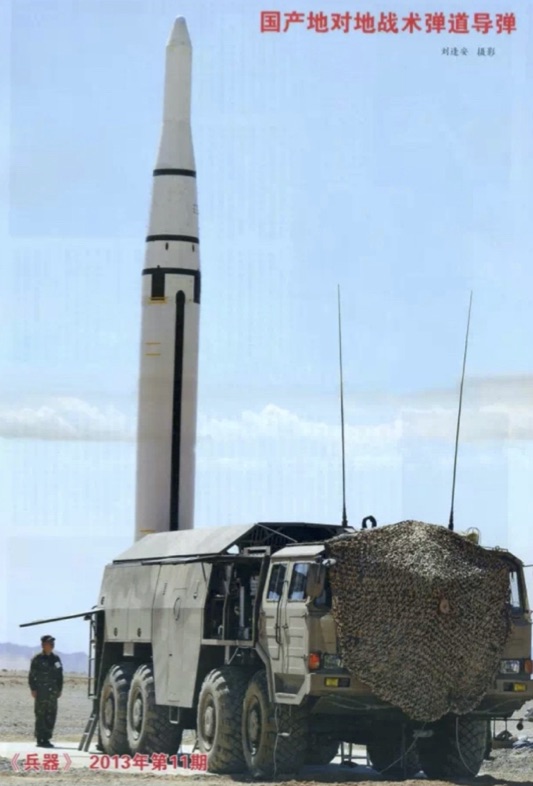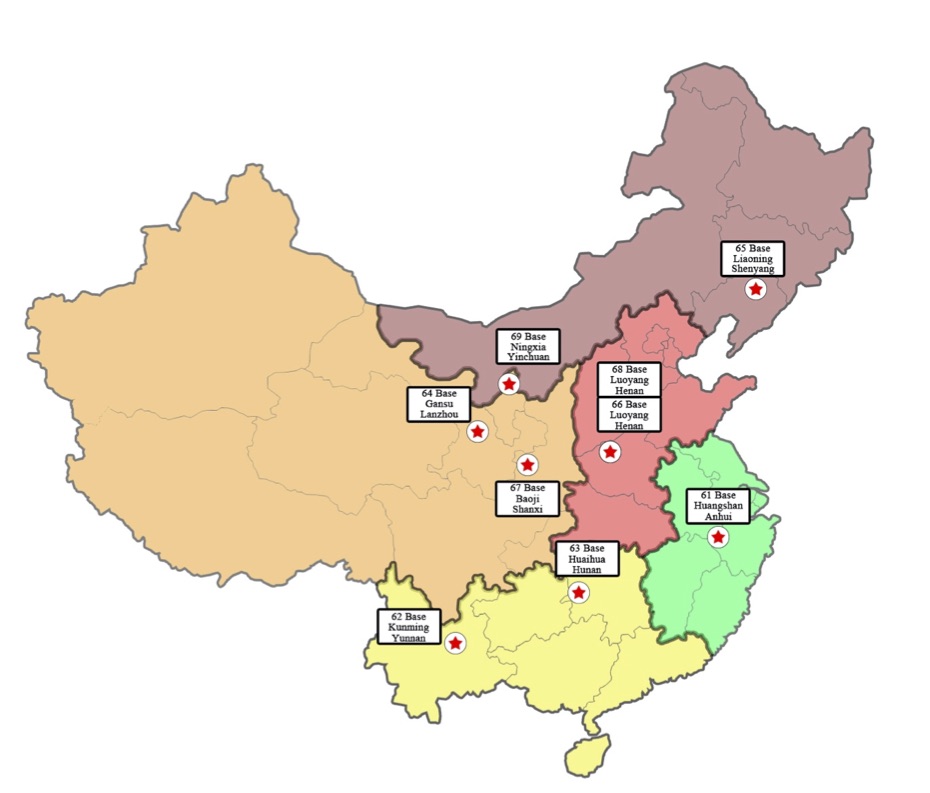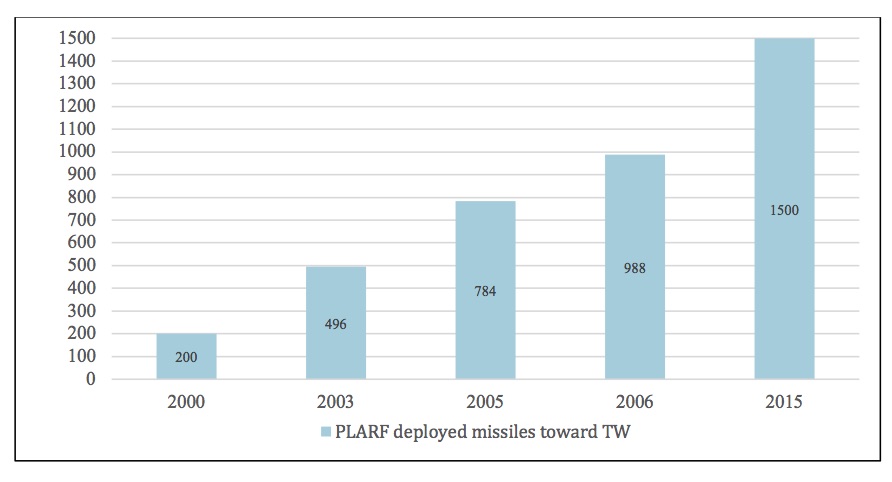
Evolving Missions and Capabilities of the PLA Rocket Force: Implications for Taiwan and Beyond
Publication: China Brief Volume: 21 Issue: 22
By:

Introduction
According to a recent Taiwan Ministry of National Defense (MND) report, the Chinese People’s Liberation Army (PLA) is strengthening its superior capabilities within the battlespace of the first island chain, and bolstering its deterrence capabilities beyond the second island chain in order to fully develop the ability to invade Taiwan by force (Central News Agency, August 31). A central assumption in the MND report is that the People’s Liberation Army Rocket Force (PLARF) will conduct saturation strikes against critical military and political facilities in Taiwan during the initial phase of the war.
However, the PLA may be shifting toward a strategy against Taiwan that is not limited solely to saturation strikes, especially as Taiwan’s defenses against these kinds of attacks have improved [1]. For the PLARF, a far more cost-effective approach than eliminating all of Taiwan’s forces on the battlefield, is to launch a series of surgical strikes that paralyze its combat capabilities. As a result, the PLARF has improved its technology in an effort to develop its “effective damage” (有效毁伤, you xiao hui shang) capabilities (CCTV, December 17, 2017).
Chinese state-owned media recently announced a “new type of missile” (新型导弹, xinxing daodan), which is part of the PLARF 1st Conventional Missile Brigade (常规导弹第一旅, Changgui Daodan di yi lu) (CCTV, August 22). The media claimed that the missile system can hit “targets under multiple protections” (多重防护下目标, duochong fanghu xia mubiao) after flying hundreds of kilometers. The report also emphasized that live ammunition training “expanded the choice of new warheads” (拓展新质弹头种类, tuozhan xinzhi dantou zhonglei) and can “effectively paralyze information nodes (有效毁瘫信息节点, youxiao huitan xinxi jie dian).”
According to Song Zhongping (宋忠平), a former PLARF official, this type of missile can be used to destroy sea and air bases and thereby obtain naval and air dominance in order to facilitate subsequent waves of fighters, warships, and amphibious landing forces onto Taiwan proper (Netease, August 22).
This article uses PLA sources, Chinese military industry publications, and analyses of PLARF launch units and their battle performance to argue that China’s newly tested guided missile is primarily intended for action in the Taiwan theater. The new missile is more accurate and lethal than previous ordinance intended for first strikes. This capability strengthens the PLARF’s ability to target. radar stations, communication nodes, and Command and Control (C2) systems in order to negate Taiwan’s early-warning and battlefield awareness capabilities.
Missions and Roles of the 1st Conventional Missile Brigade
The 2015 military reforms established both the PLARF (previously the second artillery force) as a service on par with army, navy and air forces; and created a joint regional theater command system. The Eastern Theater Command (ETC) is the main joint force responsible for operations targeting Taiwan, and includes command and control of the conventional missile forces in Base 61 (Anhui, Fujian, Guangdong, Jiangxi, Zhejiang). Nuclear forces are still under the control of the Central Military Commission (CMC). The 61st base comprises seven missile brigades (611-617) each of which is responsible for operating a specific type of missile system [2].
The 1st Conventional Missile Brigade refers to the 613th Brigade, which is deployed in Shang Rao, Jiangxi Province and armed with DF-15B short-range ballistic missiles. Since its initial deployment in 1993, the chief mission of this unit has been to target Taiwan. In the 1995-1996 Taiwan Strait Missile Crisis, the Brigade fired as many as 10 missiles into the Taiwan Straits (China Youth Daily, June 11, 2013). Taiwanese officials stated in 2004 that the primary task of PLA missile brigades deployed on the southeast coast of mainland China is to attack Taiwan. The 613th Brigade’s target list includes government authorities that are mainly in Northern Taiwan [3].
Figure 2: PLARF Base 61: Headquarters and Launch Brigades
| PLARF unit (MUCD) | Location | System | Possible target |
| 61 Base (96601) | Huangshan, Anhui (Headquarters) | ||
| 611th Brigade (96711) | Chizhou, Anhui | DF-21A* | Northeast Asia |
| 612th Brigade (96712) | Jingdezhen, Jiangxi | DF-21A* | Western Pacific |
| 613th Brigade (96713)
(The 1st Conventional Missile Brigade) |
Shangrao, Jiangxi | DF-15B | Northern Taiwan |
| 614th Brigade (96714) | Yong’an, Fujian | DF-11A | Central Taiwan |
| 615th Brigade (96715) | Meizhou, Guangdong | DF-11A | Southern Taiwan |
| 616th Brigade (96716) | Ganzhou, Jiangxi | DF-15B | Southern Taiwan |
| 617th Brigade (96717) | Jinhua, Zhejiang | DF-16A | Northern Taiwan |
Source: compiled by the authors.
Due to the 613th Brigade’s Taiwan-focused mission and its relatively advanced training level, the PLA leadership has been willing to invest resources in the unit over the long-term. PLA news accounts confirm that the 613th Brigade enjoys a special status and receives additional training resources. For example, the 613th Brigade took 17 years (1993-2010) to conduct 100 live-fire training exercises making it the first PLARF unit to reach this benchmark (China Youth Daily, June 10, 2012). The Brigade took only seven more years, from 2010-17, to complete its 200th live ammunition training (China Military Network, February 8, 2018). In comparison to other missile brigades, the training resources devoted to the 613th Brigade is much higher. This is because the ETC (successor to the Nanjing Military Region) would be at the front line of an attack against Taiwan, and the 613th brigade targets would play a central role in any assault as it is responsible for targeting political and economic centers in Taipei and surrounding areas in northern Taiwan.
Figure 3: Currently known PLARF Brigades that have Completed 100 Live Fire Exercises
| PLARF Brigade | Establishment | Missiles | Year of completion of 100th live-fire exercise | Avg. trg. [4] |
| 613th Brigade | 1993 | Unknown | 2010
(reached 200 in 2017) |
4-5 |
| 614th Brigade | 1997 | Unknown | 2015 | 2 |
| 615th Brigade | unknown | Unknown | 2016 | 2 |
| 623th Brigade | 2009 | Unknown | 2019 | 2 |
Source: compiled by authors; Avg. trg.: Average live-fire training times per launch vehicle.
A Tactical Shift From Surface-Oriented Saturation Attacks to Precision-Strikes
According to the Science of Military Strategy (战略学, zhanlue xue), the textbook used by most high-level PLA commanders, the main tactic of the 613th Brigade is conventional missile assault (常规导弹突袭, changgui daodan tuxi), which is also the “first strike” tactic that the PLARF is organized to undertake. This tactic serves multiple purposes of containment, deterrence, and control. It has a deterrence function to “contain the outbreak of conventional local wars in peacetime” (在和平时期遏制常规局部战争的爆发, zai heping shiqi ezhi changgui jubu zhanzheng de baofa );” and can also “control the spread and escalation of the conflict after the outbreak of the war (在战争爆发后遏制蔓延和升级, zai zhangzheng baofa hou ezhi manyan he shengji )” [5].
First strike tactics involve saturation attacks using a great deal of missiles against enemy “surface” targets, including airports, military ports, and concentrated ground forces. Their goal is to destroy the enemy’s defense systems and disrupt its counter-attack capabilities. As a CCTV report reiterates, missiles seek to “paralyze information nodes under multiple protections.” In addition to carrying out saturation strikes against surface targets, the PLARF is now likely capable of precision-striking “point” targets (CCTV, August 22) Furthermore, the newly tested missiles mentioned above may be able to deliver electromagnetic pulse missile (EMPM) or graphite payloads, that can destroy electronic equipment, as well as bunker-busting warheads that can penetrate underground fortifications.
Concern 1: PLARF use of EMP and Graphite Weapons
When covering PLA issues, Chinese state-owned media usually avoids using the word “destroy” (摧毁, cuihui) in an operational context, and instead uses the term “paralyze” (瘫痪, tanhuan). There are two possible reasons for this cautious word choice. First, as several analysts have pointed out, China may have tested electromagnetic pulse missile (EMPMs) (Global Times, October 18, 2013). As a result, when Beijing claims it can paralyze information nodes, it simply implies the capacity to disable Taiwan’s early warning and combat capabilities. Secondly, before the PLA conducts a large-scale triphibious landing, it will seek to blind and paralyze Taiwanese forces from mounting a timely defense.
In addition, the PLARF has gained inspiration from the 1991 Gulf War and 1999 Yugoslavia air campaign, when the US attacked a power plant using graphite missiles thereby disrupting Serbia’s national power supply (PLA Daily, September 4, 2001) [6]. If the PLA models itself after the US in the fight against Taiwan, the deterrence effect of air and missile strikes will be straightforward and widespread, causing social turmoil and psychological panic. As a result, for the PLA, attacking Taiwan’s power supply may allow it to achieve its objectives through limited warfare.
It is worth noting that the PLA historically regarded EMP weapons as part of the nuclear family because EMP create a large shockwave, optical emission and penetrating radiation. For example Major General (Ret.) Xu Guangyu (徐光裕), a nuclear expert at the previous General Staff Department, once classified “EMP weapons as a branch of nuclear weapons” (电磁脉冲炸弹属于核武器的一个种类, dianci maichong zhadan shuyú hewuqi de yige zhonglei ) and “even an advanced version of the nuclear arms” (核武器更高一级的一种发展, hewuqi geng gao yi ji de yi zhong fazha) (CCTV, June 30, 2011). This historical heritage leaves us to puzzle over the role of EMP weapons in China’s current approach to conventional and nuclear deterrence, as well as warfighting.
Concern 2: Ground-penetrating bombs
According to Weapon, which is published by China North Industries Group Corporation (CNIGC) and data from other PLA-related units, the second artillery (PLARF’s predecessor) tested a “new missile” in September 2013. The missile’s warhead was identified as a DF-15C with a shooting range of about 900 kilometers [7]. The missile test’s high degree of accuracy generated concern. State media reports indicate that it can effectively penetrate underground fortifications such as operation centers and command posts (People’s Daily, October 29, 2013). Further analysis also indicates that “ground-penetrating bombs” were provided to the 807th Brigade for firing tests. The 807th has now been renamed the PLARF 611th Brigade, and is currently deployed in the ETC in Chizhou, Anhui Province, where it is out of range of most of Taiwan’s weaponry. Successful test firings using “ground-penetrating bombs”, demonstrates that the PLA’s lethality and accuracy when using these weapons has improved, and that weapons are progressing beyond the “test” stage toward “deployment.”
Figure 4: PLA released the surface-to-surface tactical missile system, a variant of DF-15B

Source: Weapon, 2013
Is Taiwan the Only Country at Risk?
The PLA has already begun to install new ballistic missiles at Base 61 across the Taiwan Straits. The strengthening of the PLA’s missile capabilities will enhance the Central Military Commission’s confidence in the slogan of “Being capable of fighting and winning” (能打仗,打胜仗, neng dazhang, da shengzhang). The missile deployments also indicate that Beijing may be strongly tempted to use force (or the threat of force) to change the cross-strait status quo. According to Taiwan’s official statistics, the Second Artillery/PLARF deployed about 200 missiles targeting Taiwan in 2000, 496 in 2003, 784 in 2005, 988 in 2006, and about 1500 in 2015 [8].
Figure 5: The nine PLARF bases within the five theaters commands

Source: compiled by the authors.
Figure 6: Deployed PLARF missiles targeting Taiwan

Source: compiled by the authors.
To date, the PLA has not justified its need for military modernization solely in terms of competition with the United States, at least not in propaganda terms. Anyhow, there are still 30 years of technological gaps to overcome before China will achieve its goal of “building a world-class military.” However, there are many indicators that the PLA considers the U.S. military a potential adversary, and its primary obstacle to achieving its military objectives in a Taiwan contingency.
In the future, as the PLA’s conventional missile force successfully develops and deploys new types of missiles, its mission will likely diversify further. In other words, the PLARF will develop the capacity to launch more types of missiles within the same force unit. At the same time, the PLARF will also seek to improve its battlefield efficiency, and to develop the capacity to paralyze the enemy’s combat capability at a lower cost.
Finally, it is important to note that Taiwan is not the only country under threat from the PLARF’s expanding missile arsenal. The PLARF’s next deployment of its new precision strike missiles may be to units in the Northern Theater Command (NTC). Increasing the NTC’s firepower will increase to the threat not only to Taiwan, but also against U.S. troops stationed in Japan as well as other allied forces beyond the first island-chain. The stakes are higher than they appear at first sight.
Yuan-Chou Jing is an active Colonel and Associate Professor at the Graduate Institute of China Military Affairs Studies (GICMAS), F.H.K. College, NDU, Taiwan, R.O.C. Before coming to GICMAS, he served as a Director of Intelligence Division in Army Command Headquarters. His research interests focus on China’s military affairs and Japan’s defense policy. Dr. Jing was also a Senior Fellow at the Atlantic Council of the United States in 2005 and Defense Research Center, Japan, in 2014.
Yi-Ren Lai is an active Captain and Counterintelligence Officer in the Ministry of National Defense, Taiwan. He received his MA in China military affairs studies in GICMAS. His research interests include PLARF, state-of-the-art technology and China’s national security policy.
Notes
[1] 2021 QDR Editorial Board ed. 2021 Quadrennial Defense Review. Taipei: MND (Taiwan). March, 2021. pp. 8-9; MND (Taiwan). 2021 People’s Liberation Army Power Report [110年中共軍力報告]. Policy Report, 10th Congress of the Legislative Yuan, 8rd Session. September 8, 2021. pp. 31-32.
[2] David Logan, “Making Sense of China’s Missile Forces,” in Chairman Xi Remakes the PLA: Assessing Chinese Military Reforms, eds., Philp C. Saunders et al, (NDU Press, 2019), 404.
[3] Besides, missile forces deployed in Yongan and Xianyou, Fujian province, primarily attack midterm and southern Taiwan, others deployed in Meizhou, Guangdong province target southern Taiwan [部署在福建永安和仙游的導彈則可攻擊我中南部,廣東梅州的導彈則以台灣南部為重點打擊目標]. See: Wu Ming-Jie [吳明杰]. Decisive Battlefield Outside Territory [境外決戰阻敵彼岸], China Times [中國時報], July 3, 2004, 5.
[4] IISS. Military Balance 2021. p. 249.
[5] Academy of Military Science Military Strategy Research Department [军事科学院军事战略研究部] ed. Science of Military Strategy 2013 Ed. [战略学(2013年版)]. Beijing: Military Science Press [军事科学出版社]. 2013. pp. 228-236; Xiao Tian-Liang [肖天亮] eds. Science of Military Strategy 2020 Ed. [战略学(2020年修订)]. NDU Press [国防大学出版社]. 2020. pp. 384-389; Wang Zen-Ping [王振平]. Requirements for the construction of the Second Artillery is determined by the development of the military situation in Eddies in the Asian and Pacific Region [亚太地区军事形势的发展对第二炮兵建设的要求]. In Eddies in Asian and Pacific Region [亚太的漩涡, yatai de xuanwo]. Beijing: Military Science Press [军事科学出版社]. 1989. pp. 293-299.
[6] Liu Yue-Jun [刘粤军], Zhang Li-Ming [张利明], Xin-Xilu [辛锡禄]. Non-contact Warfare [非接触战]. Beijing: Military Science Press [军事科学出版社]. 2004. pp. 2-3.
[7] Liu Feng-An [刘逢安]. Domestic Ground-to-ground tactical ballistic missiles [国产地对地战术弹道导弹], Weapon [兵器], No. 11, 2013, p. 40; CMN, August 29, 2016; PLA Daily, October 15, 2018.
[8] Taiwan’s National Security Council Secretary General’s comments in the press, see: Epochtimes, January 10, 2006; Mainland Affairs Council (Taiwan). Recent information on the PLA intimidation against Taiwan [中共近期對台軍事威嚇資料]. March 13, 2007. https://reurl.cc/7okyed; MND (Taiwan). National Defense Report 2015 [104年中華民國國防報告書]. Taipei: MND. 2015. p. 46.




